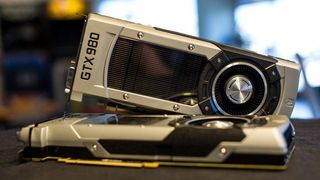Nvidia announces GTX 980 and GTX 970 "Maxwell" graphics cards for $550 and $329: here are their new features

At Nvidia Editor's Day last week, Nvidia pulled the shroud off its fresh top-of-the-line graphics cards running on the new Maxwell architecture: the $550 GTX 980 and the $329 GTX 970. Nvidia called Maxwell "the most advanced GPU ever built," but you can say that about almost every new generation of graphics hardware. More importantly, Nvidia also called Maxwell the most power-efficient GPU ever built, and that is a big deal: it delivers twice the performance per watt as Kepler, the architecture used in the 600 and 700 series cards. I've been testing a reference GTX 980 Nvidia sent, and you can read about my thoughts on the card and see our benchmarks—including dual-980 SLI benchmarks— right here .
This article is about all the new technology Nvidia is rolling out with Maxwell: a new anti-aliasing algorithm called MFAA, new lighting called Voxel Global Illumination, native downsampling support called Dynamic Super Resolution, and reduced latency for VR.
Before we dive into the new graphics features Nvidia has developed for Maxwell GPUs, here's a quick look at the specs of their new cards. You can read much more about them in our 980 testing post.
Specs | GTX 980 | GTX 970 |
CUDA cores | 2048 | 1664 |
Base clock | 1126 MHz | 1005 MHz |
Boost clock | 1216 MHz | 1178 MHz |
Single precision | 5 teraflops | 4 teraflops |
Memory config | 4GB 256-bit GDDR5 | 4GB 256-bit GDDR5 |
Memory speed | 7.0 Gbps | 7.0 Gbps |
Power connectors | 2x 6-pin | 2x 6-pin |
Outputs | 3x DisplayPort 1.2, HDMI 2.0, dual-link DVI | 3x DisplayPort 1.2, HDMI 2.0, dual-link DV |
During Editor's Day, Nvidia engineer Jonah Alben made a point of just how much more efficient Maxwell is than the previous generation Kepler. Each CUDA core is 40% more efficient, and Maxwell delivers double the performance per-watt than Kepler: 30 gigaflops per watt for the GTX 980 as opposed to 15 gigaflops per watt for the GTX 680 and 780.
Part of that efficiency comes from a new memory architecture, which includes better color compression algorithms and caching. The performance gains are especially noticeable at the high end, when running games at 4K—which makes sense, as efficient compression is more important the more pixels you have to render. 4K gaming is going to be a big push for Maxwell, which is why MFAA, Nvidia's new anti-aliasing tech, is all about improving AA efficiency.
MFAA
You've probably heard of MSAA, or multisample anti-aliasing. It's one of the most common anti-aliasing techniques in games today. It's an alternative to more computationally expensive supersampling AA techniques, which sample multiple locations within a single pixel, then combine those samples into one condensed, sharper pixel. Doing that to the whole rendered image of a game every frame is expensive. MSAA is less computationally expensive, because, as Nvidia's own page on MSAA explains , "each sub-pixel inherits the color value from the sample pixel and only assigns unique depth values to the sub-pixels (whereas supersampling calculates individual color/depth values.)"

Nvidia's new twist on this technique is called Multi-frame sampled anti-aliasing, and it supposedly delivers the equivalent quality of 4x MSAA (where each pixel is sampled four times) at the performance cost of 2x MSAA. Nvidia claims it's 30% more efficient. 4x MFAA takes two coverage samples per pixel instead of 4x MSAA's four to determine what color the pixel should be, but it uses a different pattern per pixel and a filter to combine frames and average out the color of each sampled pixel. Essentially, 2+2 = 4.
Comic deals, prizes and latest news
Sign up to get the best content of the week, and great gaming deals, as picked by the editors.
Expect to start using it: sometime after launch. While I saw MFAA demoed at Editor's Day, it wasn't enabled in the drivers for the GTX 980 reference card, and Nvidia says it will be enabled in an upcoming driver.

Wes has been covering games and hardware for more than 10 years, first at tech sites like The Wirecutter and Tested before joining the PC Gamer team in 2014. Wes plays a little bit of everything, but he'll always jump at the chance to cover emulation and Japanese games.
When he's not obsessively optimizing and re-optimizing a tangle of conveyor belts in Satisfactory (it's really becoming a problem), he's probably playing a 20-year-old Final Fantasy or some opaque ASCII roguelike. With a focus on writing and editing features, he seeks out personal stories and in-depth histories from the corners of PC gaming and its niche communities. 50% pizza by volume (deep dish, to be specific).
Most Popular





